
|
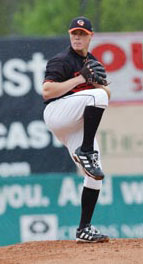 |
| Every player wearing a major league uniform has at one time or another played in the minor leagues. And the goal for all, from the first day of rookie ball, is to make it to the ‘show.’ |
Take Me Out to the Ballgame
Catch a Baysox Game at Prince George’s Stadium, and You Won’t Want to Go Home
by Louis Llovio
What will these 10-year-olds think of next?
Baseball is a game defined by statistics. Purists label eras by batting averages and ERAs, judge pitchers and fielders by records set 100 years ago and hold hitters to standards set by Babe Ruth, Ty Cobb, Ted Williams and Joe DiMaggio.
But baseball is more. It is a way of life. It is a Saturday night at the ballpark. It is freshly mowed grass, the diamond cut into the field of play. It is nine young men making their childhood dreams come true. And it is us who gather for a game that is more than a game.
Baseball purists look to history for its connection to today, but we, the spectators, look on the field as a connection to our past.
That kind of baseball — pure and simple without the contamination of controversy or the too visible intrusion of business — is alive, well and flourishing in Bowie — as it is in 250 other minor league parks throughout the nation.
Carnival at the Park
On a recent Saturday night, with the sharp smell of new-fallen rain mingling with the aroma of hot dogs and freshly popped popcorn, baseball-loving thousands flocked to Prince George’s Stadium to see the Bowie Baysox take on the Erie SeaWolves in a double header.
It was not only a night for baseball, it was a celebration. Team mascot Louie celebrated his sixth birthday, and the Baysox commemorated the event with a party that culminated with a dazzling fireworks show.
It was a summer night made for baseball. Towering lights shone on the gathered crowd. Noise concentrated in the stadium as with the crack of wood against leather, cheers and the booming voice of PA announcers Byron Hudtloff and Rob Incmikoski punctuated the chatter from the stands.
Despite the incessant rain of the past week, the field was in good shape as players warming up before the National Anthem tossed the ball around the outfield. Over the railings, kids hung programs, gloves and balls hoping for autographs. The players — boys and young men, many working their way up to the major leagues — obliged, taking a few minutes to say hello, sign a ball and pose for a picture.
They have made a child’s week and earned a fan for life. Their autographs will wind up enshrined on a wall as a lasting tribute to a night out at the ballpark and a dream come true.
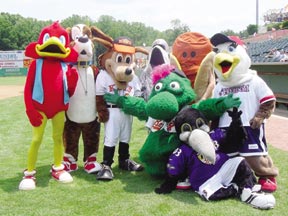 |
| The double header of June 14th marked the sixth birthday of Baysox mascot Louie, shown with arms spread wide. Between games, Louie’s guests — seven other minor-league mascots — competed in a mascot Olympics. |
Up in the stands and around the stadium, crowds enjoy the summer night. The concourse is crowded as people wait in line for old standbys — peanuts and hot dogs — and new treats from helmet fries to black-bean burgers. Children ride the merry-go-round, play on the pirate ship and get their faces painted in the play area overlooking right field. Teenagers, and some brave adults, try their hand — in fact arms — at speed pitching.
“This is all-American,” said 72-year-old Charles Warner, marveling at the scene. “It’s small towns, it’s Americana.”
This is the goal of the Baysox, says spokesman Andy Frankel: fun for the whole family. It is this commitment to family — not only from the Baysox but minor-league baseball in general — that has elevated minor league play to new levels. While major league baseball has seen a decline in attendance, minor league baseball has been steady, after astronomical growth in the last decade.
Almost 39 million fans attended games in 2001, the most since 1949. The main reason, says Stacy Martin, CFO of the Lexington Legends, is that “you don’t go to minor league baseball just to watch baseball.”
The average fan is no longer the lifelong baseball fan scouting future prospects, but a family not willing to spend $200 on a night out.
“Our main competition,” Frankel says, “is not the Orioles, but the cineplex and amusement parks.”
A seat along the third base line, 20 or so rows up at Camden Yards costs $40 to $45. The same seat costs $9 ($6 for kids 6 to 12, seniors and active military; free for kids 5 and under) at Prince George’s Stadium.
Every seat is a good one, and no one has to be left at home.
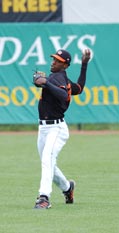 |
| In the first game of June 14th’s double header, center fielder Keith Reed led off the eighth inning with a home run that tied the game the Baysox later won. |
Compared to a movie theater, where a ticket runs from $5 up to $9 and concession prices are notoriously high, a night out at the game is relatively inexpensive. You can get a soft drink and popcorn for as low as $6, and Prince George’s Stadium offers a kid’s meal (hot dog, chips, drink and toy) for $4. Those with a little bigger appetite and deeper pockets aren’t left out, either. The price for larger beers can go as high as $6, and a bag of peanuts is $3.
Economics isn’t the only reason bringing people out to the ballpark. Growing resentment with on- and off-the-field issues the major leagues have experienced has also fueled the growth in the minors. It’s not a coincidence that as attendance has dropped in major league parks, it has grown in small towns across the nation.
From Farm to Fame
Founded as the National Association of Professional Baseball Leagues in 1901, minor league baseball has been a constant companion to the majors for over 100 years. The league saw rough times in the second decade of the last century, but a 1921 agreement allowing major league teams to own minor league teams in essence saved the minors and created a system still in place today.
Branch Rickey — the same man who years later would sign Jackie Robinson to a major league contract — of the St. Louis Cardinals used the agreement to establish a farm system to develop players.
For the player to make it to the majors, he must first play his way up through the minor league ranks. Some play their entire careers in minor-league baseball, but the goal for all, from the first day of rookie ball, is to make it to the ‘show.’
Class A is the second step in the ladder. The very young players in Class A have survived the rigors of the rookie leagues and shown initial promise.
More experienced players — the average age is 23 — hone their skills in such Double A teams as the Baysox. These players have a good shot at the show. Double A is also where some major leaguers go to rehabilitate from injuries. Rodrigo Lopez, last year’s Orioles MVP and runner-up for American League Rookie of the Year, made a rehab start in Bowie in early June.
The top of the minors is Triple A, which is just one step removed from the majors. The quality of Triple A baseball is close to what you see at a major league park. Most of the players in Triple A are waiting for their spot to open up on a major league roster.
Every player wearing a major league uniform has at one time or another played in the minor leagues. Like the Orioles of the 1970s, some teams have had great success building their rosters around young talent that has been cultivated through the farm system, filling in holes later with higher priced free agents. Stars like Dave McNally, Jim Palmer and Cal Ripken Jr. all worked their way through the Orioles’ minor- league ranks.
Between 1947 and 1949, minor league baseball saw a boom that went unrivaled until this past decade. At its peak, there were 59 leagues with nearly 450 teams. The all-time attendance record was set at the end of the explosion in 1949 with 39.7 million fans. As of 2000, there are 20 leagues with 246 teams. National attendance has passed the 33-million mark the last seven years.
In the ’50s through the ’80s, minor league baseball faltered. The majors offered better packages, and the ’50s, ’60s and ’70’s were a second golden age for baseball. Mickey Mantle, Sandy Koufax, Willie Mays, Pete Rose and Henry Aaron lead the resurgence, becoming the legends of the modern era. But by the late ’80s, with ticket prices skyrocketing, major league stadiums deteriorating and growing discontent with the corporate atmosphere of the game, the minors came into their own.
The poster children of that explosion are the legendary Durham Bulls.
The Bulls came into existence in 1902, but it wasn’t until the release of the 1987 film Bull Durham, now a classic, that they were elevated to their esteemed place in baseball mythology. The movie also helped usher minor league baseball into the national spotlight.
The story of a career minor leaguer forced to tutor an up-and-coming star pitcher captured the hearts of many baseball purists and seduced new fans. By August of 1990, the Bulls were averaging 6,202 fans per game. The total attendance for the 1990 season was 300,499, making the Bulls the first Carolina League team to pass the 300,000 mark.
The Baysox, a 10-year-old Double A affiliate of the Orioles, have averaged 398,824 in their eight full seasons at Prince George’s stadium (in 1994 they played only 37 games in the stadium, with 278,342 in attendance).
Baysox Take the Field
There’s more than a movie in the mix that brings fans to P.G. Stadium. Minor league expert Lacy Lusk told howstuffworks.com that because players rarely stay around for more than a couple of years, loyalty, in part, needs to be built by boosting the entertainment value of the game. “Winning and losing has little to do with a minor league team’s success at the gate,” he said.
That’s not to disrespect the quality of baseball.
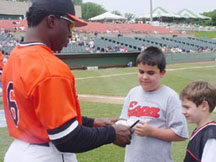 No promotion could stir in the crowd — lifting anxious fans to their feet — as the Baysox came from behind in the bottom of the eighth inning for a 6-to-3 victory in the first game of June 14th’s doubleheader. No promotion could stir in the crowd — lifting anxious fans to their feet — as the Baysox came from behind in the bottom of the eighth inning for a 6-to-3 victory in the first game of June 14th’s doubleheader.
Center fielder Keith Reed, 24, led off the eighth inning with a home run that tied the game. Twenty-four-year-old short stop Ed Rogers then squeezed off an infield hit, moved to second on the next batter’s sacrifice and subsequently stole third. Second baseman Gary Cates doubled Rodgers in to take the lead. Then a walk to Tim Raines Jr., son of former Orioles star Tim Raines Sr., loaded the bases. The stage was set for designated hitter Mike Fontenot, who cleared the bases with a triple.
That’s how the Baysox walked off the field with a late-inning victory.
One Night’s Fun
The Baysox’s 7,282 fans weren’t treated to the same thrills the second game. But a second-game loss didn’t dampen spirits, especially the spirit of the 3,518 who were seeking a trip into the Guinness Book of World Records.
Those 3,518 illustrate what makes the minors special. While the show on the field is not always major league, the show off the field is always major fun.
Between innings, the Baysox make sure the fans stay happy with a mix of games and contests. Playing Baseball Scramble, fans coach a contestant with answers to a trivia question posted in scramble style on the jumbo screen in right field. Playing Sing for Your Sub, kids hop on top of the visitors’ dugout and sing for the ballpark. The reward: a gift certificate for a free submarine sandwich. Each game a lucky fan tries to win a two-year lease on a car by pitching a ball into the sunroof of a car parked 100 feet away. These and many more between-inning promotions keep the outing fun even when play isn’t going well on the field.
On June 14, between-inning promotions took a backseat to a combined celebration of mascot Louie’s sixth birthday and a world-record attempt sandwiched between the double header.
As fans filed into the stadium, they were welcomed by cries from promotions staff who had lined up in the concourse with plastic bags holding toothbrushes, a tube of toothpaste and cups donated by a local dentist. The staff encouraged fans — many of whom were enjoying Louie’s birthday cake — to sign up and join in the night’s effort to beat the certified world record for simultaneous tooth brushing. Throughout the game, more persuasion was applied both in the stands and by the PA announcer.
Between games Louie’s guests — seven other minor-league mascots — competed in a mascot Olympics. The crowd cheered as Louie and friends played a spirited game of musical chairs. Louie ran down the right field line with the last chair to assure his victory.
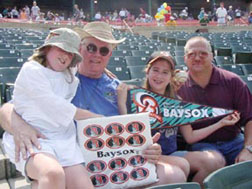 What do the children think of such an example? What do the children think of such an example?
“I think he’s funny!” said 11-year-old Alex, gasping amid laughs for a lungful of air.
Louie’s friends later joined him on top of the visitor’s dugout to join the crowd in singing “Happy Birthday.”
Before the sixth inning of the second game, festivities came full circle as the crowd pulled out their toothbrushes, loaded them up and brushed for a full minute while observers from the Guinness Book of World’s Records looked on.
Two cups were provided each brusher, one for rinsing and one for spitting. The unenviable task of collecting the now-full plastic bags fell to the maintenance crew, who went row to row collecting the dripping bags.
The previous, certified record of 3,002 was surpassed by 516 brushers. Now the wait is on for final certification from Guinness Book of World’s Records officials in England.
Playing for the Future
You can find your own brand of fun on Singles Night, Parrothead Night or Pay-What-You-Weigh Night. But not all Baysox promotions are just for fun. Like most teams in the minors, the Baysox support the communities that support the team.
Schools in surrounding counties get special attention from the Baysox, who sponsor such programs as Read and Hit a Home Run, which gives local students two tickets to their county’s Reading Night if they read four books outside the classroom. Two hundred eight schools and over 11,000 students read their way to a ball game last year.
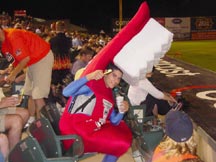 |
| On June 14, fans were welcomed with plastic bags holding toothbrushes, a tube of toothpaste and cups to join in the night’s effort to beat the certified world record for simultaneous tooth brushing. With 3,518 brushers, all that waits is official certification from Guinness Book of World’s Records officials in England. |
The team also hosts nights out at the ballpark for elementary, middle and high school kids who were voted the most improved behaviorally and academically by their teachers and administrators. The kids get a ticket to the game and are honored on the field with a pre-game ceremony and a parade. Of course, such outreach increases attendance as families and friends join their children at the game.
Closer to home, Bowie Boys and Girls Club get special Baysox attention. Before each game, a family picked at random is seated along the first base line by the Baysox dugout. Their job is to post a large K (the baseball symbol for strikeout) for every strikeout thrown by a Baysox pitcher. The promotion, called K for Kids, brings $10 for each strikeout to the club.
For their work, the Baysox were awarded the YMCA’s Community Award in 2002.
See You at the Game
“They were great! They made me dizzy!” exclaimed nine-year-old Christopher Rowe after 10 of fireworks concluded his Saturday at the ballpark that had, for many families, begun at 5:05pm.
As the smoke cleared near 10pm, the noise subsided and the bleachers emptied. Smiling families who had braved the rain showers early in the day gathered their gloves and programs and happily headed for the exit gates.
Fluorescent light still bathed the field, and the dazzling green, white and orange that are a baseball diamond stood in sharp contrast to the dark night. The games had been played, and here, at least, order reigned.
Out on the field, a solitary groundskeeper swept the infield preparing it for Sunday’s game.
The crowds will be back to see it. That diamond — perfecting those carved out of the sandlots of youth — keeps calling. We come back to revisit our youth and remember who we are. A century and a half ago, America’s poet Walt Whitman predicted the future of baseball in lines made famous by Bull Durham’s heroine, Annie: “I see great things in baseball. It’s our game. The American game.”
Whitman was right. Baseball is as much a part of our history as the monuments dedicated to our heroes 20 miles west on Route 50 in Washington, D.C. Baseball like the Baysox play at P.G. Stadium shows us — and the many nations of the world that revere the game — an America that is beautiful.

About the Author:
Louis Llovio came to Annapolis from Clearwater, Florida, where he was staff writer for MainStream, a Florida magazine, in the early ’90s. This year he published his first novel, Degas Street, is working on his second novel and writes for an on-line magazine sports-central.org. This is his first feature for Bay Weekly.
to the top
|
|





 No promotion could stir in the crowd — lifting anxious fans to their feet — as the Baysox came from behind in the bottom of the eighth inning for a 6-to-3 victory in the first game of June 14th’s doubleheader.
No promotion could stir in the crowd — lifting anxious fans to their feet — as the Baysox came from behind in the bottom of the eighth inning for a 6-to-3 victory in the first game of June 14th’s doubleheader.  What do the children think of such an example?
What do the children think of such an example?
